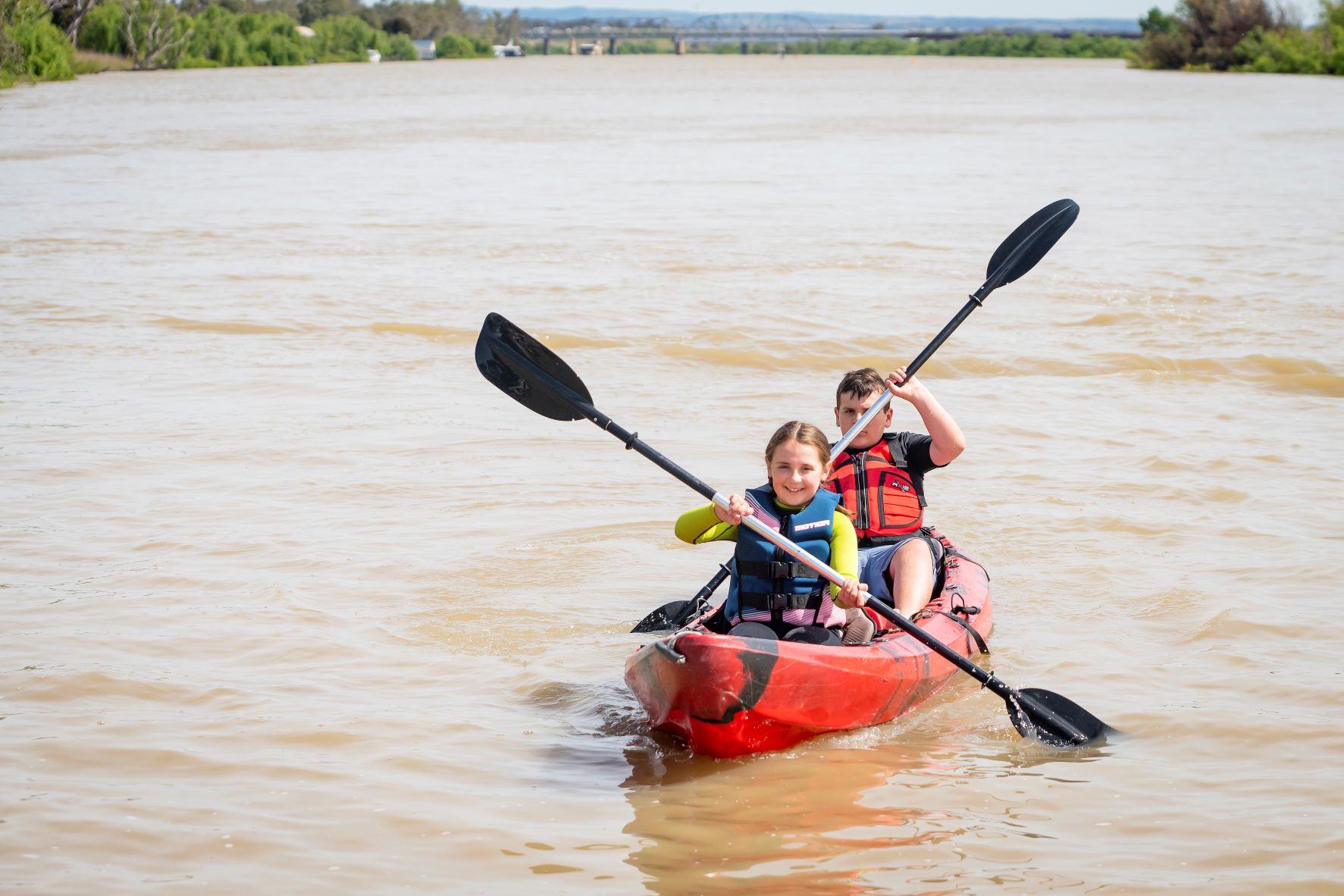Paddlecraft
It's especially important to consider safety before using a kayak, canoe, paddle board or a similar unpowered vessel. These craft sit quite low in the water and are susceptible to risks such as capsizing, blowing off course, taking on water, and reduced visibility to other vessels.
Before operating unpowered vessels of any kind, you should always check safety equipment and stock it with other necessary provisions such as water, snacks, sunscreen, etc depending on the area of operation and anticipated period of your trip.
As the paddler of your craft, you are responsible for your safety and the safety of any other people on the vessel.

Plan your trip
- Check the weather and tide information. Visit our weather page or check BOM for further information before you go out and be prepared to cancel your trip if necessary.
- Ensure your vessel is suitable for your intended area of operation. Vessels designed for use on inland or sheltered waters are not usually suited to open waters or along the coast, where waves are larger. Seagoing vessels may be just as suitable for use in a river or lake.
- Check your vessel for leaks and damage and general seaworthiness before each trip to make sure it's seaworthy
- Make sure you tell someone where you will be leaving from, the route you plan to take and your estimated time of return - this information will assist in your rescue if needed.
- Wear the correct lifejacket for the location where you are paddling.
- If travelling solo, be attentive and keep a proper lookout; be aware of hazards and changing conditions.
- Always carry a means of communication - mobile phone, emergency positioning indicating radio beacon (EPIRB), Personal Locator Beacons (PLB) and flares are some of the options you can use. Depending on where you are operating you may be required to take specific safety equipment. Use our online safety equipment tool to check what you need.
- Attach reflective tape to the vessel and paddles to increase visibility.
- Keep a buoyant, waterproof torch in your safety kit - this is essential when travelling between the hours of sunset and sunrise.
Staying safe during the journey
- Travel in a group where possible to maximise safety.
- Wear brightly coloured clothing to ensure you are visible to other water users and make sure your clothing is appropriate for the conditions and location where you are paddling.
- Make sure your skills and fitness level are adequate for the area and the conditions where you are paddling.
- If you need to abandon your unpowered craft such as a kayak, canoe or paddleboard if it is damaged or you capsize and cannot get back in follow this tips:
- Make sure that everyone is wearing a lifejacket correctly before going over the side. Surviving in cold water is hard enough without having to stay afloat as well.
- Use a means of communication to send a distress call (mobile, EPIRB, PLB, flares). Only set off flares if they are likely to be seen.
- Don't leave your unpowered craft if possible. Most unpowered craft are more easily seen by search vessels or aircraft than a person in the water. A partially submerged unpowered craft can also be used for support.
- You should generally ignore any impulse to swim ashore. Distances over water usually appear shorter than they actually are. It is always safer to stay with the unpowered craft unless you know that land is within comfortable swimming distance. Remember that the combination of your heavy clothing, cold water and the stress of the incident can reduce your normal swimming ability.
- Paddlers have greater exposure to the elements and boating in cooler weather which increases the risk of developing hypothermia from wind-chill, capsizing or damp and wet clothes. Sudden immersion in cold water can be life-threatening, especially to people who are older, unfit or under stress from being in the water. Huddle together to reduce heat loss. Avoid excessive physical activity such as swimming, as this will increase body heat loss.
- Remember hypothermia is the effect of heat loss from the body and immersion in cold water causes the body to lose heat up to 25 times faster than normal.
Safety equipment
Safety equipment requirements apply to unpowered craft such as kayaks, canoes and it is important that you are carrying suitable safety equipment for your area of operation. A correctly fitted lifejacket must be worn by each person on the vessel.
Paddleboarders have different lifejacket requirements depending on where they are operating. Make sure you check what is required.
Find out which lifejacket and safety equipment you need.
Rules
Navigation rules
The boating rules apply to people operating unpowered recreational craft.
Big ships, little vessels
All operators of unpowered recreational craft need to be aware of the risks associated with different types of vessels using the water at the same time and safe operation near large commercial vessels.
Alcohol and drugs
It is an offence to operate a vessel (powered or unpowered) and to have a blood alcohol concentration of .05 or more or to be under the influence of drugs. Know the rules that apply to alcohol, drugs and boating.
Safe loading
Overloading your unpowered craft seriously reduces stability making your vessel more likely to capsize. Follow the manufacturer's guide for the recommended weight capacity and the number of people your unpowered craft is designed for and stow all items securely.
Kayak or canoes fitted with a motor
Any vessel fitted with any type of engine or motor must be registered, the operator hold a boat operator's licence, registration number displayed and appropriate safety equipment carried.
Exemption for kayaks and canoes fitted with electric motor of not more than 150 newtons
Exemptions from registration, boat licence and carriage of specified safety equipment apply for kayaks or canoes fitted with an electric motor of not more than 150 newtons (33.7 lb thrust) when operated by a person of 16 years of age or older.
The exemption is subject to the conditions below:
- The kayak or canoe is fitted with an electric motor of not more than 150 newtons (33.7 lb thrust)
- The kayak or canoe and electric motor are maintained to the original manufacturer’s specifications and design capabilities
- The power source for the electric motor is a marine grade closed cell 12-volt battery.
- The vessel must operate in semi-protected or protected waters only.
Safety equipment and lifejacket requirements for kayaks or canoes apply regardless of the fitting of a motor.
Note: some motor manufacturers badge the 150 newtons motor as 34 lb thrust which is accepted as meeting the maximum of 33.7 lb thrust criteria.
Paddleboarding
Paddleboarding has become a very popular activity on our waterways. It is vital to check the wind conditions before taking to the water. Wind is a major risk for paddleboarders. You may be setting off in smooth waters, but offshore winds can create breaking waves meaning you can end up in choppy seas faster than you think, or being swept out to sea .
Here are some top tips for paddleboarders to help keep them safe:
- Lifejackets: lifejackets are required to be worn on a paddleboard on any inland waters including rivers and lakes. They are not compulsory on coastal waters within 400 metres of the shore, but Marine Safety SA recommends wearing a lifejacket whenever on the water.
- Wear a leg leash: paddleboarders need to use a leg leash. A leg leash connects the operator to their craft which helps prevent separating from your paddleboard if you fall in the water.
- Check the weather before you go: Offshore winds can cause paddleboarders to be blown out to sea quickly. Conditions can change quickly. Do not paddle when there are offshore winds which can blow you out into deeper water and make it difficult to paddle back into shore.
If possible, carry a form of waterproof communications like a mobile phone in a waterproof pouch so you can make contact with someone if needed.
Accidents and incidents
If your unpowered vessel is involved in an incident or you witness an incident you have a legal obligation to stop and provide assistance. Where additional assistance is required and you have a mobile phone with you, dial 000 to alert the appropriate authority.
If you are involved in an accident that results in death, or injury requiring medical attention to any person, or damage to property exceeding $300, you must report the matter to a police officer nearest the place of the accident/incident or a Marine Safety Officer within 48 hours of the accident or incident. Vessel accidents or incidents can be reported to a Marine Safety Officer online here.


